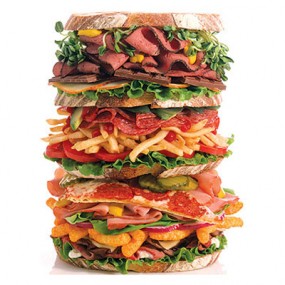- Fitness (19)
- News & Reviews (25)
- Nutrition (20)
- Science (10)
- Supplements (6)
- Technologies (8)
- The Arts (9)
Western Diets Are Making the World Sick
April 16th, 2011
 From NPR’s ‘Fresh Air’: When physician Kevin Patterson described his experiences working at the Canadian Combat Surgical Hospital in Afghanistan, he noticed that the Afghan soldiers, police and civilians he treated in Kandahar had radically different bodies from those of the Canadians he took care of back home.
From NPR’s ‘Fresh Air’: When physician Kevin Patterson described his experiences working at the Canadian Combat Surgical Hospital in Afghanistan, he noticed that the Afghan soldiers, police and civilians he treated in Kandahar had radically different bodies from those of the Canadians he took care of back home.
“Typical Afghan civilians and soldiers would have been 140 pounds or so as adults. And when we operated on them, what we were aware of was the absence of any fat underneath the skin,” Patterson says. “Of course, when we operated on Canadians or Americans or Europeans, what was normal was to have most of the organs encased in fat.”
In a conversation on Fresh Air, Patterson tells Terry Gross that the effects of urbanization are making people everywhere in the world both fatter and sicker.
“Type 2 diabetes historically didn’t exist, only 70 or 80 years ago,” says Patterson. “And what’s driven it is this rise in obesity, especially the accumulation of abdominal fat. That fat induces changes in our receptors that cells have for insulin. Basically, it makes them numb to the effect of insulin.”
He explains that the increase in abdominal fat has driven the epidemic of diabetes over the last 40 years in the developed world — and that he’s now seeing similar patterns in undeveloped regions that have adopted Western eating patterns.
Patterson explains that in his Canadian practice, where he takes care of indigenous populations near the Arctic Circle, there is a marked increase in the number of diabetic patients he sees. “The traditional Inuit culture of relentless motion and a traditional diet consisting mainly of caribou, Arctic char, whale and seal has been abandoned over this period of time for Kentucky Fried Chicken and processed food and living a life very similar to ours,” he says.
Part of the problem, says Patterson, is that it’s so much cheaper for processed food to be flown into the Arctic Circle than fresh food. “There’s no roads or rail access to any of those communities,” he says. “So a 4 liter jug of milk can cost you $10 or $11. But there’s a very clear parallel between that and the inner city. In poorer neighborhoods in North American cities, fresh food is either not available or extremely expensive compared to — on a calorie-by-calorie basis — compared to fast food available on every street corner.” Continue reading »
Sprinting at 95
February 23rd, 2011
By David Muir & Joel Siegel: Ida Keeling is a 4-foot-6, 83-pound bundle of wonder, a woman defying the conventions of age. She takes only one prescription drug, and recalls names and dates with the speed of someone half her age.
Active and healthy and living alone in her Bronx, N.Y., apartment, she could pass for 75. She says she feels even younger. “Like a puppy,” she declares. “I feel younger now than when I was in my 30s and 40s and had all those problems. Then I was aged!”
Over her long life, Keeling has endured the kind of heartbreak and hardship that could grind anyone down. Her mother passed away when she was a child, and her husband died suddenly of a heart attack when he was just 42. She lost two sons, Charles and Donald, to drug-related killings in 1979 and 1981.
In running, Keeling found a refuge. Continue reading »
Filed under News & Reviews | Comments Off on Sprinting at 95Dark Chocolate Health Benefits
September 2nd, 2010
 By Alexis Wolfer: The New York Times [has] reported that chocolate, in moderation is good for your heart. In fact, women (from Sweden in this study) who ate 1 to 2 servings of dark chocolate (between two-thirds of an ounce and one ounce) each week had almost one-third fewer cases of heart failure than those who avoided the sweet stuff. They say that chocolate may lower blood pressure and that the flavonoids in cocoa may reduce blood vessel inflammation.
By Alexis Wolfer: The New York Times [has] reported that chocolate, in moderation is good for your heart. In fact, women (from Sweden in this study) who ate 1 to 2 servings of dark chocolate (between two-thirds of an ounce and one ounce) each week had almost one-third fewer cases of heart failure than those who avoided the sweet stuff. They say that chocolate may lower blood pressure and that the flavonoids in cocoa may reduce blood vessel inflammation.
2010 was a good year for dark chocolate lovers — the news is full of promising research regarding its effects on heart, stress, brain & liver, not to mention tastebuds! — Dr. Cathie
BeautyBean … New York Times … Telegraph (UK) ... Daily Mail (UK) … Medical News Today
Filed under Nutrition | Comments Off on Dark Chocolate Health BenefitsErnestine at 74
August 25th, 2010
Ernestine Shepard was shopping for swimsuits with her sister in 1992 when they realized they weren’t in such great shape; so at the age of 56…Ernestine took her first aerobics class. Today she is 74, still running 80 miles a week, lifting free-weights, setting records and teaching classes.
Filed under Fitness | Comments Off on Ernestine at 74




